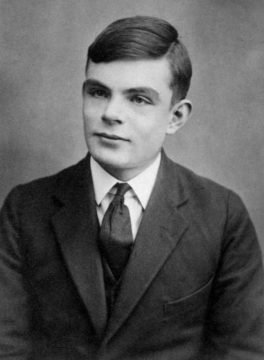Patti Wigington in ThoughtCo:
 Alan Mathison Turing (1912 –1954) was one of England’s foremost mathematicians and computer scientists. Because of his work in artificial intelligence and codebreaking, along with his groundbreaking Enigma machine, he is credited with ending World War II. Turing’s life ended in tragedy. Convicted of “indecency” for his sexual orientation, Turing lost his security clearance, was chemically castrated, and later committed suicide at age 41.
Alan Mathison Turing (1912 –1954) was one of England’s foremost mathematicians and computer scientists. Because of his work in artificial intelligence and codebreaking, along with his groundbreaking Enigma machine, he is credited with ending World War II. Turing’s life ended in tragedy. Convicted of “indecency” for his sexual orientation, Turing lost his security clearance, was chemically castrated, and later committed suicide at age 41.
…During World War II, Bletchley Park was the home base of British Intelligence’s elite codebreaking unit. Turing joined the Government Code and Cypher School and in September 1939, when war with Germany began, reported to Bletchley Park in Buckinghamshire for duty. Shortly before Turing’s arrival at Bletchley, Polish intelligence agents had provided the British with information about the German Enigma machine. Polish cryptanalysts had developed a code-breaking machine called the Bomba, but the Bomba became useless in 1940 when German intelligence procedures changed and the Bomba could no longer crack the code. Turing, along with fellow code-breaker Gordon Welchman, got to work building a replica of the Bomba, called the Bombe, which was used to intercept thousands of German messages every month. These broken codes were then relayed to Allied forces, and Turing’s analysis of German naval intelligence allowed the British to keep their convoys of ships away from enemy U-boats.
…In addition to his codebreaking work, Turing is regarded as a pioneer in the field of artificial intelligence. He believed that computers could be taught to think independently of their programmers, and devised the Turing Test to determine whether or not a computer was truly intelligent. The test is designed to evaluate whether the interrogator can figure out which answers come from the computer and which come from a human; if the interrogator can’t tell the difference, then the computer would be considered “intelligent.”
…In 1952, Turing began a romantic relationship with a 19-year-old man named Arnold Murray. During a police investigation into a burglary at Turing’s home, he admitted that he and Murray were involved sexually. Because homosexuality was a crime in England, both men were charged and convicted of “gross indecency.” Turing was given the option of a prison sentence or probation with “chemical treatment” designed to reduce the libido. He chose the latter, and underwent a chemical castration procedure over the next twelve months. The treatment left him impotent and caused him to develop gynecomastia, an abnormal development of breast tissue. In addition, his security clearance was revoked by the British government, and he was no longer permitted to work in the intelligence field. In June 1954, Turing’s housekeeper found him dead. A post-mortem examination determined that he had died of cyanide poisoning, and the inquest ruled his death as suicide. A half-eaten apple was found nearby. The apple was never tested for cyanide, but it was determined to be the most likely method used by Turing.
More here.
